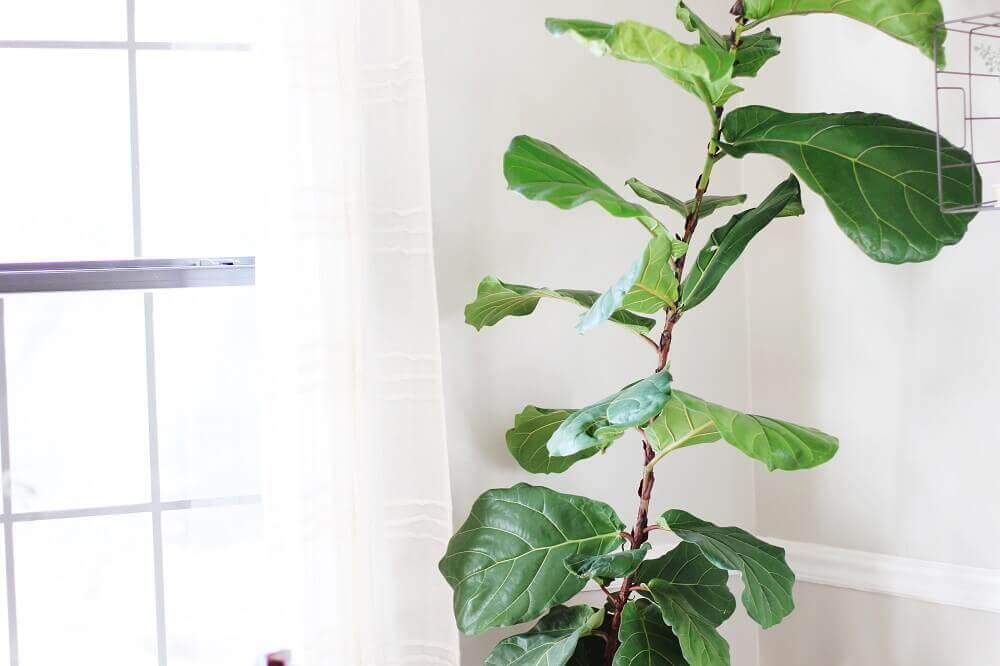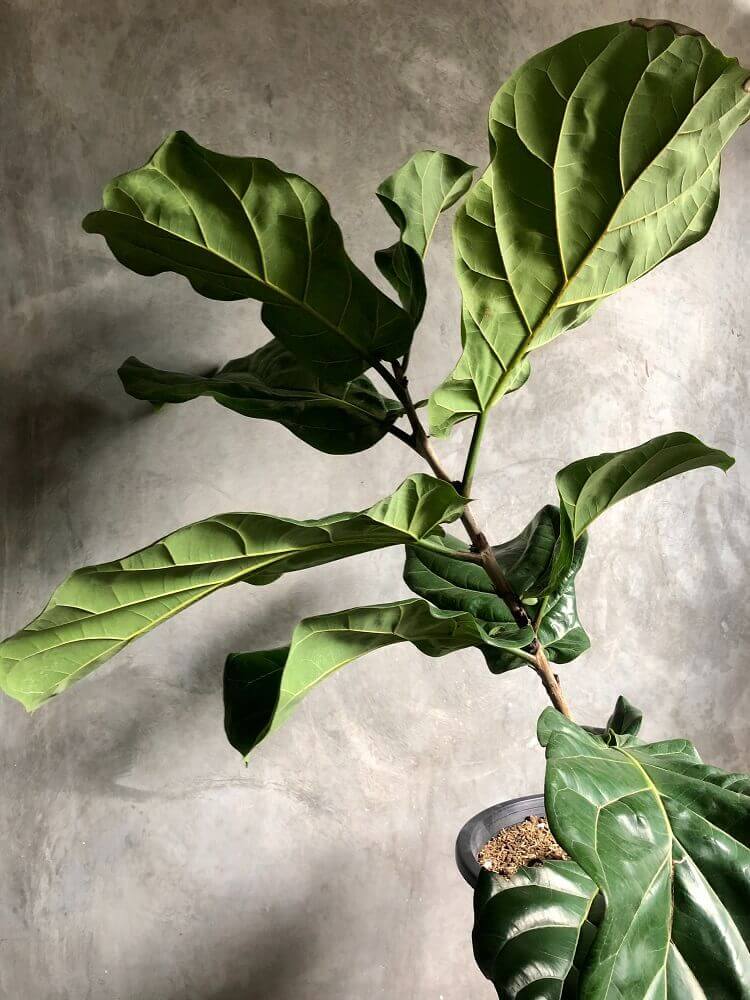
Have you ever tried growing a fiddle leaf fig at home but failed every time miserably? Well, this much-adored houseplant is very sensitive. Even the slightest change in the environment can make it lean, leggy, and eventually give it a weird crooked look.
However, if taken care of properly, the indoor plant can reach around 10 feet in height, enhancing your home’s appeal with its exquisite long leaves and charm. But what makes them lean? Is there any way to fix it and let it grow back straight?
Well, we totally understand your concern regarding your beloved plant. That is why we are going to resolve all your queries related to the plant’s abnormal shape and share some tips to prevent it from leaning.
TL; DR
Due to insufficient fertilizer, inadequate sunlight, improper watering, and airflow, your fiddle leaf fig tends to lean. The indoor plant can also get a crooked appearance if it gets too tall. However, if you ensure that your fiddle leaf fig plant is getting enough sunlight, adequate fertilizer, and the right amount of water and air, you can prevent it from leaning. In case your green gem becomes too tall or outgrows from a particular side, make sure to arrange support for it to stand upright or just prune the leaves.
Table of Contents
4 Reasons That Can Make Your Fiddle Leaf Fig Lean
Generally, a fiddle leaf fig leans when its trunk becomes weak and cannot stand straight. This happens because of improper care. Here, we will be listing the four crucial conditions that restrict your gorgeous fiddle leaf fig from growing straight. Let’s take a look.
-
Inadequate Sunlight
The fiddle leaf figs have their origins in the African rainforests, meaning the plant loves warm and moist weather. If you obstruct it from getting what it likes, how can you expect the plant to flourish? When your fig plant gets inadequate sunlight, it gets less energy, which in turn, weakens the trunk. Also, when the leaves of the plant start to grow in distance, the trunk loses its balance.
The plant searches for light and grows in the direction where it finds a proper light source. So, if the light settings are not appropriate, your plant might lean on a specific side where it can come in contact with light and warmth.
Well, you need to take preventive measures from the very beginning when you first notice its crookedness. Otherwise, once the trunk of your fig plant becomes strong, you can hardly fix its shape.
Read: How Much Light Do Fiddle Leaf Figs Need? (Light Requirements + Low light Problems)
-
Underwatering And Overwatering
Watering your fiddle leaf fig plant is the most crucial part of its care routine. Both overwatering and underwatering can prove to be dangerous for your houseplant. While overwatering can lead to root rot, underwatering can push it towards decay and death.
When you overwater your plant, the excess water accumulates near the root and damages it. Also, overwatering restricts the plant from absorbing nutrients, leaning it on a specific side.
On the other hand, without proper water, plants fail to supply the nutrients to the trunk, making it super weak. And as a result, the trunk can hardly hold itself straight and starts leaning. So, you should be very careful while watering your green baby.
Read: Fiddle Leaf Fig Water Requirements (How Much And How Often To Water)
-
Deficiency Of Nutrients
When a plant does not get the necessary nutrients, its trunk may get weak, and leaves might not grow well. And owing to such reasons, the plant might lose its ability to produce food using sunlight. Well, your fiddle leaf fig is no exception to it.
Without proper nutrients, your fiddle leaf fig plant can be weak, leafy, and lean on one side. Since the fiddle leaf fig features big and broad leaves, it needs more energy to retain its health and growth.
To ensure the sound health of your fig plant, you must fertilize it routinely. And always use the fertilizer in compost or liquid form. But the question is, how to identify that your fig plant is leaning due to nutrient deficiency? It’s because whether your plant gets insufficient nutrients, inadequate water, or less light, it tends to show similar signs.
So, here the tricky part comes! You have to do a little investigation and find out whether the leaning of your plant is due to insufficient fertilizer. Well, the most common signs of poor nutrients include the yellowing of leaves, interrupted growth, smaller leaf size, etc.
There is one more reason that can restrict your fiddle leaf fig to absorb the right amount of nutrients even if you fertilize it well. If you do not re-pot your plant for too long, the soil can become acidic and create obstacles before its nutrient absorption ability.
Read: Do Fiddle Leaf Figs Need Fertilizer? (How Often And Which Ones To Buy)
-
Rootbound Plant
With the right resources, a fiddle leaf fig grows really fast, which could cause rootbound growth. In case, you leave your fiddle leaf fig in the same pot for around two to three years, the chances of it getting rootbound are high. And this can make your fig grow weirdly on one side.
Now the question is: how can you assess that your house plant is rootbound? Fiddle leaf figs keep giving hints when it’s unwell, so you have to pay careful attention to detect them.
For instance, if its roots come out from the drainage hole, probably your plant has rootbound. And when a plant is rootbound, it can never really absorb nutrients until and unless you repot it.
Preventive Methods To Follow To Keep Your Plant Straight

Every problem has a solution. There are several ways to prevent your green baby from leaning. Hopefully, after reading this far, you might know that with proper light, nutrients, water, and care. This is how you can keep your plant upwards. To give you a clear insight into the possible solutions, we are going to describe each aspect comprehensively for a better understanding.
-
Give Proper Exposure To Sunlight
The tropical indoor plants enjoy the warmth. The more light it gets, the better it thrives. If your fiddle leaf fig plant does not get sufficient sunlight from all directions, it might lean on one side in search of a light source.
Even if you place your plant where it comes in contact with mild yet bright sunlight, make sure you keep rotating it from time to time. This is just to ensure that your plant receives sunlight evenly from all directions.
When you keep changing its position once a week, no part of the plant has to lean in any specific direction to get in touch with warmth. And through this way, you can avert it from leaning. A good 6 to 8 hours of sunlight can ensure your plant’s optimal growth.
One more thing to remember is to never let your gorgeous fiddle leaf fig get direct sunlight as it can dry out the leaves. The best solution is to filter the light using curtains.
-
Provide The Right Amount Of Water
Both overwatering and underwatering can result in leaning. Water your green baby only when it needs it. There are multiple ways by which you can judge whether your fig plant requires water. To name a few, you can go for a DIY process by running a finger test or just by poking a stick into the soil. Else, you can just use your moisture meter to find that out.
If you are running a DIY moisture test, make sure the surface of the soil is dry. Dig your finger or stick in the soil; if it feels sticky, skip watering. On the other hand, if you are using a moisture meter, water your plant only when the tool reads 3-4.
Numerous factors, including the time of year, adequacy of light, level of humidity, temperature, etc., determines the water needs of your fig plant. If your fiddle leaf fig gets enough sunlight and has a good drainage system, water it every one to two weeks.
In short, instead of watering your plant blindly, water it according to the moisture content in its soil. This way, you can keep the trunk strong enough to hold the tree straight.
-
Use The Right Fertilizer
Unknowingly, many new plant owners tend to fertilize their plants with loads and loads of nutrients. Little do they know that this way, they are inviting danger. A fiddle leaf fig grows fast and smoothly when fed with the right fertilizer in the ratio of 3-2-1 N-P-K.
That means the fertilizer should consist of 3% nitrogen, 2% of phosphorus, and 1% of potassium. While Nitrogen helps grow its beautiful, glazy, big leaves, phosphorus works on its root growth. And at the time of manuring, make sure that it is either compost or liquid fertilizer. Experts suggest using liquid fertilizer over compost, as this way, you can keep track of the absorption ability of your fig plant.
Now comes the most crucial part! What Is the right time to fertilize your fiddle leaf fig? Well, that totally relies on the type of fertilizer you are using. Summer and spring are ideally the best time for your plant’s growth. It is the right time to manure your plant regularly in a safe quantity. During autumn and winter, you need to pause fertilizing your plant too frequently.
-
Prune The Leaves To Avert Leaning
When you do not rotate your plant, leaving one part to outgrow, your beloved plant can lose its balance and lean. However, there is an excellent way to solve it, and that is pruning. But be very careful while handling the job.
Before initiating the pruning program, plan the cuts beforehand. Your goal should be to restore the former shape of your plant. Once you have figured out the cuts, mark the part, and gently run your scissors accordingly.
However, do not commit the mistake of pruning the leaves of the lower part. It can make the upper part heavier, resulting in the leaning of the trunk.
-
Re-pot Your Plant To Prevent Rootbound
Unless you repot your plant every two to three years, it might get rootbound, sloping on one side. But if you fail to re-pot your plant precisely, it might leave negative consequences.
Here are a few simple tips for a successful re-potting:
- Water your fiddle leaf fig plant a day before you plan to replace the pot. Once you successfully repot your plant, water it again. This way, you can adjust the moisture content in the soil and let the plant settle in.
- Make sure the pot you use is big enough and has drainage holes to drain out the excess water.
- Using well-draining soil can be suitable for your fiddle leaf fig’s smooth growth.
Right Airflow
Lastly, yet most importantly, keep a keen eye to see whether your fiddle leaf fig is getting sufficient airflow. With better airflow, the plant’s stem gets enough strength to stand upright. A fantastic way to prevent your green baby from leaning is keeping it outside where it can touch the fresh breeze.
However, if the condition outside is not suitable for your fig leaf fig, wiggling the stem can work as the best alternative option. Just wiggle the stem from right to left, and you can definitely notice the difference in just a few days.
FAQs About Droopy Fiddle Leaf Fig Plant
How often should I shake my fiddle leaf fig to prevent leaning?
The stem of a fiddle leaf fig might get weak and start to lean if it does not get outdoor wind. But a gentle shake in the stem can work as artificial airflow, giving strength to the plant to stand straight. Shake the plant for around 5 to 10 minutes daily to get the best result.
Where should I place my fiddle leaf fig to keep it from leaning?
One of the primary reasons that cause your plant to lean is inadequate light. Place your fiddle leaf fig in front of your window from where it can get filtered sunlight. Also, make sure to rotate its position once a week to prevent it from outgrowing on a particular side.
Conclusion
With their beauty and charisma, fiddle leaf figs can instantly bring a change to your home’s ambiance, spreading happiness and positivity. But the plant is very sensitive, and needs utmost care to stay healthy, straight, and bloomed. A wrong move can drag it towards decay and leaning. Follow the above-enlisted tips and let us know in the comment section whether they have worked for your houseplant.
References:

From childhood, I have been extremely fascinated with plants and gardening. That has eventually led me to pursue BSc and then MSc in botany from the University of Calcutta. My deep love for plants has probably stemmed from the gorgeous terrace garden that I have seen my father nurture as long as I can remember.
